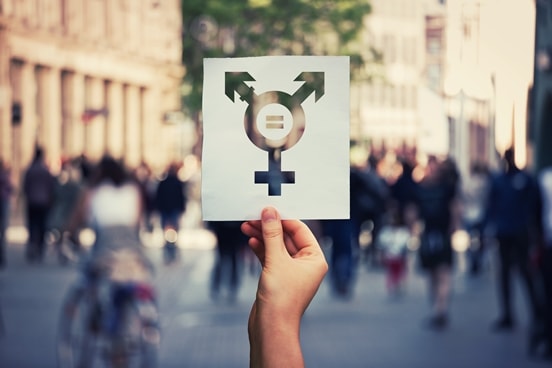Facial feminization: hairline lowering
 The hairline is an important feature characterizing both male and female faces. The typical male hairline has an M-shape, characterized by a receding hairline. With increasing age, this M-shape will be reinforced by progressive receding hairlines.
The hairline is an important feature characterizing both male and female faces. The typical male hairline has an M-shape, characterized by a receding hairline. With increasing age, this M-shape will be reinforced by progressive receding hairlines.
The hairline in women is more round and oval and it has either no or only extraordinarily little receding hairline.
This makes the female forehead appear smaller than then male forehead. The lowering of the hairline makes an originally male face more feminine, harmonious, and even.
To achieve a uniform image of the feminization of transgender persons, there are numerous other options besides the adaptation of the hairline. For a comprehensive overview, please click here: Face Feminization
One option is the adjustment of the eyelids to make the face look more feminine. You can find information about this method here: Adjustment of the eyelids.
The hairline lowering is an important aspect of gender identification
Patients who want to adapt their male gender to their female identity can adapt this area of the head as well. It is surgically feasible to achieve the pulling forward of the hairline. This gives the face a more feminine contour with fewer receding hairlines.
In the context of the surgical intervention, we strive to achieve the ideal distance between 5 and 6.5 cm between the eyebrow and the hairline. This makes the forehead smaller. In this manner, it will appear more harmonious and even.
When is hairline lowering indicated in the context of the facial feminization?
 In general, the hairline lowering is recommended if the hairline is behind the transition where the head changes into a vertical position.
In general, the hairline lowering is recommended if the hairline is behind the transition where the head changes into a vertical position.
To give your male face a feminine shape, the hairline should be as deep as possible in order to make the forehead look smaller.
The hairline lowering: This is how the operation is performed
To make the forehead more feminine in the context of a transgender operation, the removal of skin parts will be needed. After that, the hairy scalp is moved forward by up to 2.5 cm.
These are the individual steps in the operation for the facial feminization at the hairline:
- Anaesthesia
As a rule, the operation is performed under general anaesthesia. - Incision along the hairline
The incision is performed slightly above the hairline. This is deliberately not made completely smooth so that it does not result in any straight scar. The scar formation should be designed in such a way that the hair grows through the scar. So, the latter becomes as good as invisible. - Displacement of the hairy scalp
The moving scalp on the back of the head is ideally displaced forward by 1.5 to 2 cm. - Skin removal
The skin area is adapted to the head shape. - Scalp fixation
The bone is also used for the stabilization of the result. This is to prevent the scalp from pulling back again.
What complications can be caused by the hairline lowering?
The lowering of the hairline is performed under general anaesthesia. Consequently, the usual surgical risks arise. You will be informed in detail about them before the performance of the intervention.
Apart from that, no further serious and lasting complications are to be expected. Sometimes bruises occur in the area of the operation, but they heal again after a few days. Mild pain can be managed very easily with a simple pain medication.
In many cases, the area around the forehead appears numb and insensitive. Within a year at the latest, this will be regulated again for most of the patients. Within a period between 2 and 4 weeks, many patients notice increased hair loss, which particularly affects the fine hair on the forehead.
Is there a visible scar left after the hairline lowering?
 The surgeon carries out the incision unevenly above the hairline.
The surgeon carries out the incision unevenly above the hairline.
This approach has two main benefits: On the one hand, the scar is later located behind the hairline. Consequently, it is covered by the hair growing back.
On the other hand, it looks more natural due to the irregular shape. Ideally, it is no longer visually visible after its complete healing.
When can I go back to my normal everyday life after the hairline lowering?
The so-called hairline lowering is a comparatively simple intervention in the context of the facial feminization with a short recovery time. Just a few days after the intervention, you can do light work again by pursuing your regular activities. After just 6 weeks you can dye your hair again.
What change can I expect after the performance of the hairline lowering?
The hairline can be moved forward by up to 2.5 cm as part of facial feminization in gender operations. When it comes to the face area, even very small changes have an extreme effect on the whole face.
The hairline lowering results in a balance of the proportions of the entire face. The size and dominance of the forehead disappears. As a consequence, the face looks much more feminine overall. This makes the hairline lowering an important building block in sex reassignment surgery.
How much does the hairline lowering cost?
 The hairline lowering intervention is usually not covered by the health insurance companies. We would be glad to provide you with a cost estimate after an initial consultation interview.
The hairline lowering intervention is usually not covered by the health insurance companies. We would be glad to provide you with a cost estimate after an initial consultation interview.
When can I wash my hair again after the performance of the hairline lowering?
You can wash your hair again almost immediately after the performance of the intervention. Use a mild shampoo to prevent an uncomfortable burning of the fresh wound.
You should also dry the skin thoroughly afterwards. In addition, you have to remove the remaining moisture.